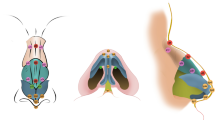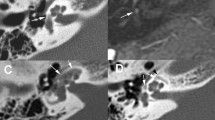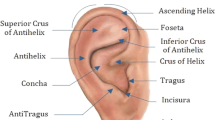Abstract
Otoplasty for the correction of protruding ears is characterized by various techniques and a common and popular cosmetic procedure. For the surgeon, whether beginner or advanced, it is essential to understand the principles and master techniques for standard auricular deformities before applying further sophisticated methods, because a lot of complications and failures are caused by wrong indication and incorrect surgical techniques. The different surgical steps are best learned from teaching models. Therefore, we developed two different silicone models of protruding ears with moderate auricular deformities: one with conchal hyperplasia for the training of conchal resection, and one without antihelix for creating an antihelical fold by suturing technique, based on computed tomography scans of patients. The silicone ear models were evaluated during four standardized surgery courses for residents in otorhinolaryngology by 91 participants using specially designed questionnaires. Nearly all participants rated the training on the auricular models as very helpful (n = 51) or good (n = 31); the scores for the different techniques and properties of the models ranged from 2.0 to 2.6 in a range from 1 (very good) to 4 (inadequate). The good results demonstrate the possibility for learning different surgical otoplasty techniques with this newly designed teaching tool.








Similar content being viewed by others
References
Burns P, Miller I, Timon C, Walsh M (2008) Otorhinolaryngologists’ interest in facial plastic surgery: a survey in the United Kingdom and Ireland. J Laryngol Otol 122:299–302
Naumann A (2007) Otoplasty—techniques, characteristics and risks. GMS Curr Topics Otorhinolaryngol Head Neck Surg 6:1–14
Rettinger G (2011) Surgery of the auricle and external canal, in ENT-head and neck surgery: essential procedures. Georg Thieme Verlag, Stuttgart
Gilbody J, Prasthofer AW, Ho K, Costa CL (2011) The use and effectiveness of cadaveric workshops in higher surgical trainings: a systematic review. Am R Coll Surg Engl 93:347–352
Alberty J, Filler TJ, Schmäl F, Peuker ET (2002) Thiel method fixed cadaver ears. A new procedure for graduate and continuing education in middle ear surgery. HNO 50:739–742
Benkhadra M, Bouchot A, Gérard J, Genelot D, Trouilloud P, Martin L, Girard C, Danino A, Anderhuber F, Feigl G (2011) Flexibility of Thiel’s embalmed cadavers: the explanation is probably in the muscles. Surg Radiol Anat 33:365–368
Carey JN, Rommer E, Sheckter C, Minneti M, Talving P, Wong AK, Garner W, Urata MM (2014) Simulatio of plastic surgery and microvascular procedures using perfused fresh human cadavers. J Plast Reconstr Aesthet Surg 67:e42–e48
Sheckter CC, Kane JT, Minneti M, Garner W, Sullivan M, Talving P, Sherman R, Urata M, Carey JN (2013) Incorporating of fresh tissue surgical simulation into plastic surgery education: maximizing extraclinical surgical experience. J Surg Educ 70:466–474
Loh CY, Gunn E, Pennell DJ, Athanassopoulos T (2014) Pinnaplasty: a porcine training model. J Plast Reconstr Aesthet Surg 67:868–869
Narayanan V, Narayanan P, Rajagopalan R, Karuppiah R, Rahman Z, Wormald P-J, van Hasselt CA, Waran V (2015) Endoscopic skull base training using 3D printed models with pre-existing pathology. Eur Arch Otorhinolaryngol 272:753–757
Schneider G, Voigt S, Rettinger G (2011) Evaluation of a face model for surgical education. Laryngo-Rhino-Otol 90:543–547
Schneider G, Müller A (2004) Multi-center study of the Jenaer model of the temporal bone. Laryngo-Rhino-Otol 83:363–366
Staindl O, Siedek V (2007) Complications of auricular correction. GMS Curr Topics Otorhinolaryngol Head Neck Surg 6:1–13
Acknowledgments
The authors would like to thank the cooperation partner 3di GmbH Jena for the realization of the models, and the German Ministry of Economics (BMWi) for providing financial support to this project.
Author information
Authors and Affiliations
Corresponding author
Ethics declarations
Conflict of interest
The authors indicate that they have no financial relationship with the organization that sponsored the research.
Rights and permissions
About this article
Cite this article
Schneider, G., Voigt, S. & Rettinger, G. Computed tomography-based training model for otoplasty. Eur Arch Otorhinolaryngol 273, 2427–2432 (2016). https://doi.org/10.1007/s00405-015-3797-0
Received:
Accepted:
Published:
Issue Date:
DOI: https://doi.org/10.1007/s00405-015-3797-0




